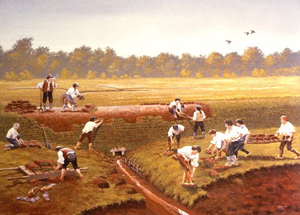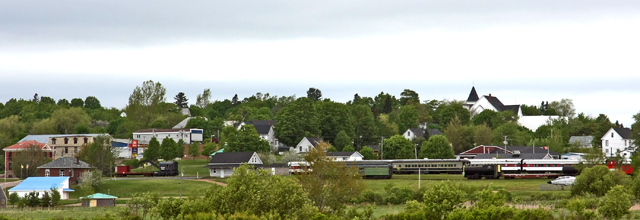A bit of history of the area where Hillsborough is located...
The first European settlers were the Acadians, who co-existed peacefully with the native people of the area. The Acadians chose the area because of the large tidal flats, similar to the land which had been reclaimed from the sea in their native France.  They held back the tides with a series of dykes and soon they had a prosperous farming area known as Blanchard Settlement.
They held back the tides with a series of dykes and soon they had a prosperous farming area known as Blanchard Settlement.
This settlement ended with the expulsion of the Acadians in 1755. After the fall of Fort Beausejour, a Major Fry set out by boat to round up the Acadians in Shepody and Hillsborough and bring them back to Fort Beausejour. They ran into unexpected resistance, and when they returned to their boat, they left behind 23 men, killed or wounded. This was known as the Battle of Hillsborough. Three months later, they returned with a 500 man force, burning the buildings and deporting the Acadians. The area remained relatively uninhabited for the next decade, except for a few returning Acadians.
In 1766 a group of German settlers in the Philadelphia area answered an advertisement by the Franklin Land Company (Benjamin Franklin’s Company) for land in the British Colony of Nova Scotia. They sailed to the Moncton area, but 3 years later in 1769., dissatisfied with the promises of the Franklin Land Co., they moved to the Hillsborough area to obtain land grants from the government. They encountered all kinds of difficulties in trying to farm the dyke land soils. However, a Mr. Belliveau, an Acadian who had returned to farm in the Belliveau Village area, came to their aid. He visited them, saw their plight, and seeing that their mother tongue was German, he decided to instruct them in more productive farming methods, and how to utilize the wild plants in the area.
The area really prospered during the 1800's, the wooden ship building era. Ships were constructed in the area, loaded with lumber and sailed to England where both the ship and cargo were sold. Gypsum was mined, processed and shipped to New England. Hay was pressed and shipped to the large cities. Albertite was shipped to Boston where a gas from it was used for street lights. An 1882 map of Hillsborough shows a plaster wharf, lumber wharf and a coal wharf. The concrete silos close to our property are the remnants of the plaster wharf. Most of the older home in the village date back to this era.
The Village of Hillsborough is located in southeastern New Brunswick, on the banks of the Petitcodiac River, approximately 30 kilometers south of the city of Moncton, close to Hopewell Rocks and Fundy National Park. Its population counts today approximately 1300. The village is home to the Hillsborough Elementary School and Caledonia Regional High School. Hillsborough is also home to the Albert County Chamber of Commerce and the historic Salem and Hillsborough Railroad Museum and the William Henry Steeves Museum. Taking pride in its rural character, Hillsborough is a prime destination for the outdoor enthusiast. The village's economy today is primarily based on tourism, although forest products, agriculture and the service industry contribute significantly to the local economy.
For more information on Hillsborough you can visit the village's website under www.villageofhillsborough.ca.













